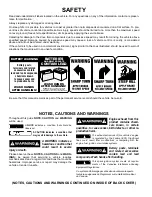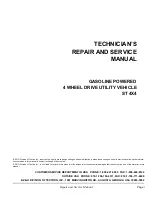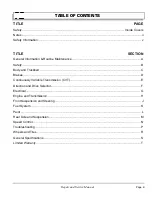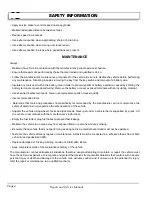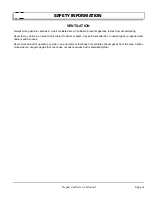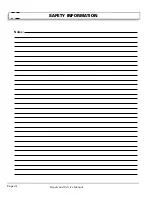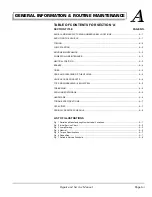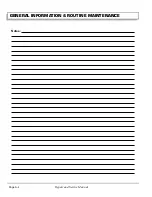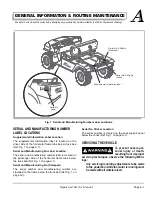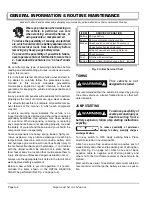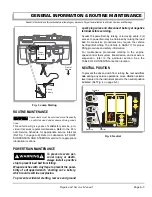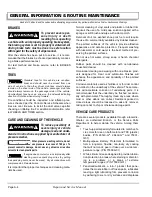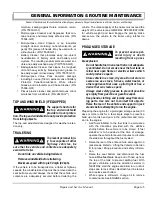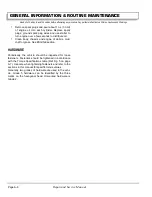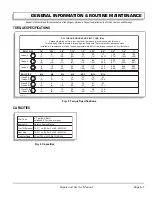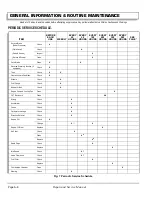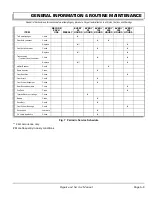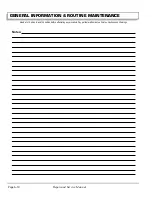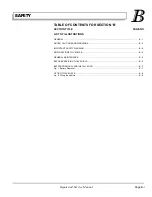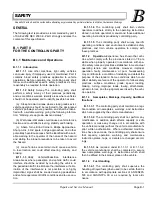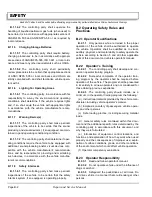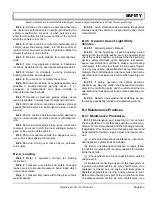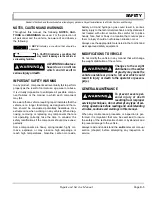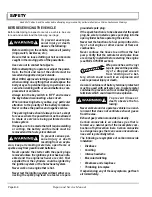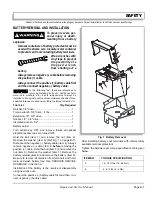
GENERAL INFORMATION & ROUTINE MAINTENANCE
Page A-4
Repair and Service Manual
Read all of Section B and this section before attempting any procedure. Pay particular attention to all Notes, Cautions and Warnings
BRAKES
To prevent severe per-
sonal injury or death
resulting from operating
a vehicle with an improperly operating brake system,
the braking system must be properly maintained. All
driving brake tests must be done in a safe location
with regard for the safety of all personnel.
After the vehicle has been put into service, it is recom-
mended that the brakes be checked periodically conduct-
ing a brake performance test.
For test method and brake service, refer to BRAKES
section.
TIRES
Standard tires for this vehicle are uni-direc-
tional and should never be moved from one
side of vehicle to the other. driver side tires should always
remain on the driver side of the vehicle. passenger side tires
should always remain on the passenger side of the vehicle.
Uni-directional tires have an arrow on the sidewall indicating
direction of rotation when moving forward.
Tire condition should be inspected and inflation pres-
sures checked per the Periodic Service Schedule when
tires are cool. Be sure to install the dust valve cap after
checking or inflating tire. For additional information, refer
to WHEELS AND TIRES section.
CARE AND CLEANING OF THE VEHICLE
To reduce possibility of
severe injury or vehicle
damage, read and under-
stand all instructions supplied by manufacturer of
pressure washer.
When pressure washing vehicle, do not
use pressure in excess of 700 psi. To
prevent cosmetic damage, do not use any abrasive or reactive
solvents to clean plastic parts.
If engine does not start or runs improperly after
washing, remove spark plug wires (by pulling
the spark plug boots, never the wires). Dry all connections with
compressed air. Reinstall wires.
It is important that proper techniques and cleaning mate-
rials be used.
Normal cleaning of vinyl seats and plastic or rubber trim
requires the use of a mild soap solution applied with a
sponge or soft brush and wipe with a damp cloth.
Removal of oil, tar, asphalt, shoe polish, etc. will require
the use of a commercially available vinyl/rubber cleaner.
The painted surfaces of the vehicle provide attractive
appearance and durable protection. Frequent washing
with lukewarm or cold water is the best method of pre-
serving the painted surfaces.
Do not use hot water, strong soap or harsh chemical
detergents.
Rubber parts should be cleaned with non-abrasive
household cleaner.
Occasional cleaning and waxing with non-abrasive prod-
ucts designed for ‘clear coat’ automotive finishes will
enhance the appearance and durability of the painted
surfaces.
Corrosive materials used as fertilizers or for dust control
can collect on the underbody of the vehicle. These mate-
rials will accelerate corrosion of underbody parts. It is
recommended that the underbody be flushed occasion-
ally with plain water. Thoroughly clean any areas where
mud or other debris can collect. Sediment packed in
closed areas should be loosened to ease its removal,
taking care not to chip or otherwise damage paint.
VEHICLE CARE PRODUCTS
There are several products, available through a local dis-
tributor, an authorized Branch, or the Service Parts
Department, to help maintain the vehicle. Among them
are:
•
Touch-up paint specially formulated to match vehi-
cle colors for use on both metal and TPE (plastic)
bodies. (P/N 28140-G**, 28432-G** and 75831-
G01)
•
Multi-purpose Battery Protectant formulated to
form a long-term, flexible, non-tacky, dry coating
that will not crack, peel or flake over a wide tem-
perature range. (P/N 75500-G01)
•
White Lithium Grease designed to provide lubrica-
tion protection in areas where staining or discolor-
ing is a problem, or in areas of extreme
temperature ranges. (P/N 75502-G01)
•
Penetrant/Lubricant, a 4-in-1 product that pene-
trates the most stubborn of frozen parts, lubricates
leaving a light lubricating film, prevents corrosion
by adhering to wet or dry surfaces and displaces
!
!
!
!
Summary of Contents for ST 4X4
Page 6: ...Page iv Repair and Service Manual TABLE OF CONTENTS Notes...
Page 10: ...Repair and Service Manual SAFETY INFORMATION Page viii Notes...
Page 12: ...GENERAL INFORMATION ROUTINE MAINTENANCE Page A ii Repair and Service Manual Notes...
Page 24: ...SAFETY Page B ii Repair and Service Manual Notes...
Page 34: ...BODY AND TRUCKBED Page C ii Repair and Service Manual Notes...
Page 50: ...BRAKES Page D ii Repair and Service Manual Notes...
Page 68: ...CONTINUOUSLY VARIABLE TRANSMISSION CVT Page E ii Repair and Service Manual Notes...
Page 74: ...DIRECTION AND DRIVE SELECTOR Page F ii Repair and Service Manual Notes...
Page 80: ...ELECTRICAL Page G ii Repair and Service Manual Notes...
Page 114: ...FRONT SUSPENSION AND STEERING Page J ii Repair and Service Manual Notes...
Page 128: ...FUEL SYSTEM Page K ii Repair and Service Manual Notes...
Page 136: ...PAINT Page L ii Repair and Service Manual Notes...
Page 142: ...REAR AXLE AND SUSPENSION Page M ii Repair and Service Manual Notes...
Page 152: ...SPEED CONTROL Page N ii Repair and Service Manual Notes...
Page 160: ...TROUBLESHOOTING Page P ii Repair and Service Manual Notes...
Page 168: ...WHEELS AND TIRES Page R ii Repair and Service Manual Notes...
Page 174: ...GENERAL SPECIFICATIONS Page S ii Repair and Service Manual Notes...
Page 180: ...LIMITED WARRANTY Page T ii Repair and Service Manual Notes...
Page 182: ...Page T 2 Repair and Service Manual LIMITED WARRANTY Notes...

